| |
Refractive surgery |
What types of research are important in improving laser eye surgery?
The cornea is the outer surface of the eye and thus is easily subject to a range of problems such as abrasion and other trauma, infection, and inflammation. Of course, corneal surgery may open the cornea to these same challenges. Thus, a major area of corneal research is corneal healing: how to bring the cornea back to full function after a problem occurs or after surgery. A laser surgeon who performs corneal healing research is not only likely to know the latest advances in the field, but also to be highly aware of potential post-operative problems and how to prevent or solve them.
What is a refractive error?
To refract means to bend. When you have a refractive error, the light rays going into your eye are bent and focused by the cornea and lens in such a way that they are not focused on the retina and thus form a blurred image.
What are the four main types of refractive errors?
The four major types of refractive error are myopia (nearsightedness), hyperopia (farsightedness), astigmatism, and presbyopia.
The most common refractive error is myopia or nearsightedness, whereby the light rays are focused in front of the retina. In astigmatism, irregular curvature of the cornea and lens results in the image being focused on different planes not coinciding with the retina. Hyperopia or farsightedness occurs when the light rays are not bent enough and the image is focused behind the retina. You can also have a combination of myopic astigmatism or hyperopic astigmatism. Presbyopia is a loss of the elasticity of the naturally occurring crystalline lens whereby individuals cannot focus clearly at close distances and need reading aids. This becomes apparent around the fourth decade of life.
How is a refractive error measured and what is a diopter?
When you read a prescription, a minus sign means nearsightedness and a plus sign means farsightedness. The first number in the prescription indicates the amount of myopia or hyperopia you have. If there are numbers written in the next two columns, these indicate the amount of astigmatism, if any, and the axis where it is present. The unit to measure a refractive error is called a diopter or D. For example, if your prescription says -2 or -2D or -2 sph or -2 sphere, it means that you are nearsighted and require 2 diopters of correction. A diopter is a unit of measurement related to the focal length of an optical system including the human eye. The larger the diopter the shorter the focal length.
How can a refractive error be corrected?
The standard method for correction of any refractive error is glasses or contact lenses. A newer correction available is Corneal Refractive Therapy (CRT), available from Wilmer's optometrists at Green Spring Station, which uses special contact lenses that mold the cornea. There are also several types of surgical options depending on the type of refractive error; some options use lasers, some do not.
What are surgical options for correction of myopia (nearsightedness)?
The most common surgical procedures are the excimer-laser-based procedures called LASIK (laser assisted in-situ keratomileusis) and photorefractive keratectomy (PRK).
What are surgical options for correction of astigmatism?
If the astigmatism is combined with myopia or hyperopia, the surgeon can correct astigmatism using LASIK or PRK. If the astigmatism is not combined with myopia or hyperopia, non-laser incisional methods such as astigmatic keratotomy (AK) may be used.
What are surgical options for correction of hyperopia (farsightedness)?
Wavefront-guided LASIK and LASEK are approved for correction of farsightedness.
How does laser vision correction work?
Laser vision correction changes the curvature of the cornea, one of the structures of the eye that focuses light on the retina. If the eye is too large or the cornea's curvature too great, light focuses improperly and distant objects appear blurred. This is called nearsightedness or myopia. If the cornea's curvature is too flat, close objects appear blurred. This is called farsightedness or hyperopia. With the laser we can reshape the contour of the cornea by sculpting extremely small amounts of corneal tissue. The four types of laser treatment we use are called Wavefront-guided LASIK, LASIK, PRK and LASEK. |
What is LASIK? |
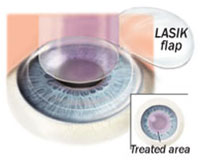 |
|
LASIK, or laser-assisted in-situ keratomileusis, combines delicate surgical procedures and laser treatment. First we surgically create a "flap" of corneal tissue less than a third the thickness of a human hair, and lift the flap to one side. We then apply laser energy to reshape the cornea according to carefully calculated measurements. When treating nearsightedness, we use the laser to decrease the cornea's relative curvature. When treating farsightedness, we increase the cornea's relative curvature. We then reposition the corneal flap. A naturally-adhering bandage, the flap helps to improve results and speed recovery. LASIK may be used for nearsightedness, nearsightedness plus astigmatism, farsightedness, and farsightedness plus astigmatism. |
What is PRK? |
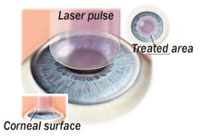 |
|
In PRK, or photorefractive keratectomy, we apply the laser directly to the cornea according to carefully calculated measurements, without creating a flap. For nearsightedness we decrease the relative curvature; for farsightedness we increase the relative curvature. At the conclusion of the procedure we place a transparent "bandage" contact lens over the cornea to promote healing. PRK is presently used to treat nearsightedness, nearsightedness plus astigmatism, farsightedness, and farsightedness plus astigmatism. |
What is LASEK? |
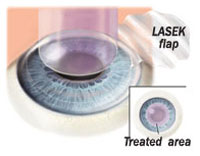 |
|
In LASEK, or laser epithelial keratomileusis, we surgically treat the outermost layer of the cornea to create and move aside a sheet of cells a third the thickness of a LASIK flap (see "The LASIK treatment"). We then apply the laser to reshape the cornea. For nearsightedness we decrease the relative curvature; for farsightedness we increase the relative curvature. At the conclusion of the procedure we replace the sheet of cells and cover the cornea with a transparent "bandage" contact lens to promote healing. LASEK is presently used to treat nearsightedness, nearsightedness plus astigmatism, farsightedness, and farsightedness plus astigmatism. LASEK is reserved for patients who have thin corneas, are at risk of occupational damage to the eye, are reluctant to have a LASIK flap, or have corneal disease that precludes the LASIK procedure. |
What are corneal rings? |
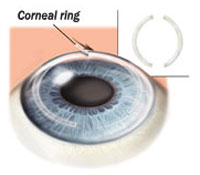 |
|
In the corneal ring segment treatment, we make an incision in the side of the cornea, place a tiny plastic ring inside the cornea to flatten its curvature, then close the incision. The ring treats mild nearsightedness and mild astigmatism in patients with very thin corneas, and may be used to treat a disorder called keratoconus. The rings are not visible to the patient or to others, and may be removed if necessary. |
What are phakic intraocular lenses? |
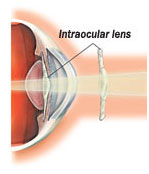 |
|
The phakic intraocular lens, which has recently been FDA approved is a non-laser treatment. In the intraocular lens treatment we make an incision in the side of the cornea, place an artificial lens between the iris and the eye's natural lens, then close the incision. The treatment is a potential alternative for patients whose refractive error is outside that treated by LASIK-higher nearsightedness and farsightedness. The lens is not visible to the patient or to others, and may be removed if necessary. |
About Me |
Am I a good candidate for laser surgery?
You should be at least be 20 years of age to ensure stable vision, and should not have scars in the cornea or any autoimmune diseases. A complete evaluation by a specially trained tometrist, together with a Wilmer laser surgeon, is required to determine if you are a candidate. The evaluation lasts 1 - 2 hours and includes a complete dilated eye exam, refraction, and corneal topography exam.
Are there contraindications?
There are certain medications that should be discontinued prior to surgery. Persons who are pregnant or nursing should postpone their surgery until their hormonal status is back to normal. People with certain corneal conditions such as keratoconus should be excluded prior to surgery.
Is there a problem if I wear contact lenses?
You should discontinue contact lens wear prior to your evaluation. Long-term contact lens wear can cause reversible surface changes in the cornea also known as corneal warpage. Soft contact lenses should therefore be removed at least two weeks prior and hard or rigid gas-permeable lenses at least three weeks prior to the evaluation. |
| |
|
|
|
|
